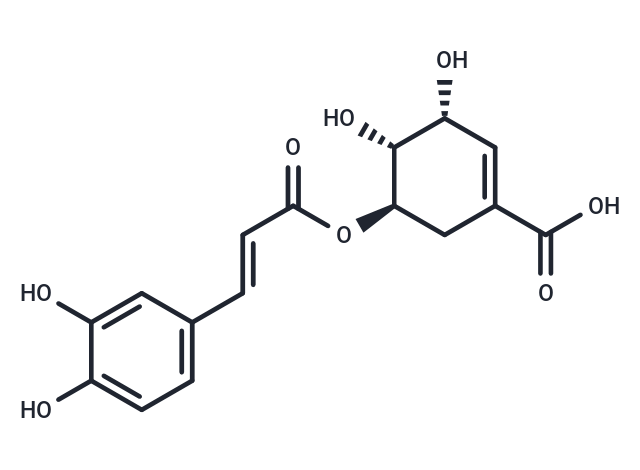Shopping Cart
- Remove All
 Your shopping cart is currently empty
Your shopping cart is currently empty

5-O-Caffeoylshikimic acid shows anti-oxidative activity; it also shows anti-inflammatory activity, the underlying mechanism was associated with downregulation of nuclear factor-κB.

| Pack Size | Price | Availability | Quantity |
|---|---|---|---|
| 1 mg | $116 | In Stock | |
| 5 mg | $282 | In Stock | |
| 10 mg | $418 | In Stock | |
| 25 mg | $695 | In Stock | |
| 50 mg | $988 | In Stock | |
| 1 mL x 10 mM (in DMSO) | $370 | In Stock |
| Description | 5-O-Caffeoylshikimic acid shows anti-oxidative activity; it also shows anti-inflammatory activity, the underlying mechanism was associated with downregulation of nuclear factor-κB. |
| In vitro | Cytotoxic activity of saponins and phenolic compounds have been described in the literature, but no reports were found on their multidrug resistance (MDR)-modulating effects on human mdr1 gene-transfected mouse lymphoma cell line.Methylprototribestin, structurally related compounds and a mixture of 3 acetylated isomers of methylprotodioscin were investigated for antiproliferative effect and modulation of drug accumulation. RESULTS: The growth inhibitory dose (ID50) of the compounds ranged from 12.64 to 20.62 mug/ml. Methylprototribestin was the most effective resistance modifier. However, methylprotodioscin, pseudoprotodioscin, prosapogenin A of dioscin, tribestin and 5-O-Caffeoylshikimic acid showed moderate MDR reversal activity. In a checkerboard method, methyloprototribestin and the mixture of the 3 acetylated isomers enhanced the antiproliferative effects on MDR cells in combination with doxorubicin. CONCLUSION: Based on these results, methylprototribestin and the mixture of the 3 acetylated isomers can be recommended for further in vivo experiments in combination with anthracyclines in human MDR-cancer xenograft transplanted mice[1] |
| Molecular Weight | 336.29 |
| Formula | C16H16O8 |
| Cas No. | 73263-62-4 |
| Smiles | O[C@@H]1C=C(C[C@@H](OC(=O)\C=C\c2ccc(O)c(O)c2)[C@@H]1O)C(O)=O |
| Relative Density. | 1.60 g/cm3 (Predicted) |
| Storage | keep away from direct sunlight,store at low temperature,keep away from moisture | Powder: -20°C for 3 years | In solvent: -80°C for 1 year | Shipping with blue ice. | ||||||||||||||||||||||||||||||||||||||||
| Solubility Information | DMSO: 50 mg/mL (148.68 mM) H2O: 20 mg/mL (59.47 mM), sonification is recommended. | ||||||||||||||||||||||||||||||||||||||||
Solution Preparation Table | |||||||||||||||||||||||||||||||||||||||||
H2O/DMSO
DMSO
| |||||||||||||||||||||||||||||||||||||||||

Copyright © 2015-2024 TargetMol Chemicals Inc. All Rights Reserved.